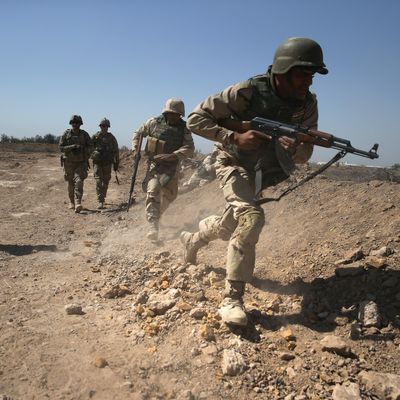
The fall of Ramadi last month sparked calls for new strategy in the coalition campaign against ISIS, but on Monday during the G-7 summit in Germany, President Obama admitted, “We don’t yet have a complete strategy.” The line was just one word off from a gaffe Obama made in September, just before unveiling a four-point plan to “degrade and ultimately destroy” ISIS.
Naturally, Republican presidential contenders were quick to pounce. “If I were commander in chief, it would not take nine months to work with our military leaders to develop a complete strategy to destroy ISIS and protect American security interests and values,” said former Texas governor Rick Perry. His rivals were similarly vague on how they’d take out ISIS, but on Tuesday we got some specifics on the new strategy the Obama administration has been hammering out. While the plan has yet to be finalized, U.S. officials say President Obama is ready to send around 500 American troops to help train Iraqi forces to retake Ramadi.
The New York Times reports that, for many months, some in the administration have argued that the initial focus of the campaign against ISIS should be retaking Mosul, the second-largest city in Iraq. Others said that rather than making an ambitious push to recapture the northern city, they should be looking to Anbar Province in the west, which borders coalition partners Saudi Arabia and Jordan and is home to many of Iraq’s Sunnis. The debate was settled when ISIS took Ramadi, the capital of Anbar Province, revealing that the coalition’s offensive has been less successful than U.S. officials suggested.
As part of the revised plan, the U.S. military will probably establish a new base near Habbaniya, which is about 20 miles outside Ramadi. “We are looking at it closely,” a U.S. official told the Washington Post. “We need to firm up our presence out there. There’s been a debate about getting a site in the eastern part of Anbar for some time. Iraqis had asked for it. Ramadi forced the issue.” The 500 additional U.S. troops, who would join the roughly 3,000 already in Iraq, would use the base to train Iraqi forces and help them devise a counterattack against ISIS.
Anbar Province is also a key region because it’s home to many Iraqi Sunnis, who are seen as essential to the fight against ISIS. Efforts to train Iraq’s military have fallen short of expectations, and the Shiite-led government’s failure to win over Iraq’s Sunni minority is a large part of the problem. President Obama has repeatedly emphasized that U.S. forces can’t win the fight for Iraq (or rather won’t, as he’s vowed that American troops won’t be sent into ground combat). At the G-7 summit Obama explained the strategy isn’t “complete” because Iraqis still need to work out the details on when and where training will take place. “One of the things that we’re seeing in Iraq is that we’ve got more training capacity than we have recruits,” Obama said. “A big part of the answer there is outreach to Sunni tribes,” he added, which “has not been happening as fast as it needs to.” About 8,000 Iraqis have been trained by U.S. forces so far, and according to the Times the strategy calls for recruiting and training another 3,000 Iraqi soldiers before attempting to retake Ramadi.
Critics say that still won’t be enough, and the U.S. should be sending in heavier artillery, and U.S. troops that can direct airstrikes, at the very least. “One has to wonder whether this president just wants to wait out the next year and a half and basically do nothing to stop this genocide, bloodletting, horrible things that are happening throughout the Middle East,” Senator John McCain said on Monday.






























